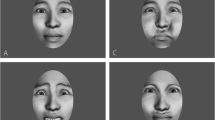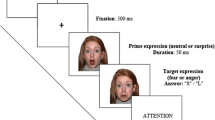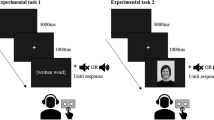Abstract
An affective priming paradigm with pictures of environmental scenes and facial expressions as primes and targets, respectively, was employed in order to investigate the role of natural (e.g., vegetation) and built elements (e.g., buildings) in eliciting rapid affective responses. In Experiment 1, images of environmental scenes were digitally manipulated to make continua of priming pictures with a gradual increase of natural elements (and a decrease of built elements). The primes were followed by presentations of facial expressions of happiness and disgust as to-be-recognized target stimuli. The recognition times of happy faces decreased and the recognition times of disgusted faces increased as the quantity of natural/built material present in the primes increased/decreased. The physical changes also influenced the evaluated restorativeness and affective valence of the primes. In Experiment 2, the primes used in Experiment 1 were manipulated in such a way that they were void of any recognizable natural or built elements but contained either similar colours or similar shapes as primes in Experiment 1. This time the results showed no effect of priming. These results were interpreted to give support for a view that the priming effect by environmental pictures is due to the primes representing environmental scenes and not due to the presence of certain low-level colour or shape information in the primes. In all, the present results provide evidence that perception of environmental scenes elicits automatic affective responses and influences recognition of facial expressions.




Similar content being viewed by others
References
Ainsworth, R. A., Simpson, L., & Cassell, D. (1993). Effects of three colors in an office interior on mood and performance. Perceptual and Motor Skills, 76, 235–241.
Aronoff, J., Woike, B. A., & Hyman, L. M. (1992). Which are the stimuli in facial displays of anger and happiness? Configurational bases of emotion recognition. Journal of Personality and Social Psychology, 62, 1050–1066.
Bargh, J. A., Chaiken, S., Govender, R., & Pratto, F. (1992). The generality of the automatic attitude activation effect. Journal of Personality and Social Psychology, 62, 893–912.
Bargh, J. A., Chaiken, S., Raymond, P., & Hymes, C. (1996). The automatic evaluation effect: Unconditional automatic attitude activation with a pronunciation task. Journal of Experimental Social Psychology, 32, 104–128.
Baron, R. A., Rea, M. S., & Daniels, S. G. (1992). Effects of indoor lighting (illuminance and spectral distribution) on the performance of cognitive tasks and interpersonal behaviors: The potential mediating role of positive affect. Motivation and Emotion, 16, 1–33.
van den Berg, A., Koole, S., & van der Wulp, N. (2003). Environmental preference and restoration: (How) they are related? Journal of Environmental Psychology, 23, 135–146.
Cacioppo, J. T., & Gardner, W. L. (1999). Emotion. Annual Review of Psychology, 50, 191–214.
De Houwer, J., Hermans, D., & Eelen, P. (1998). Affective and identity priming with episodically associated stimuli. Cognition and Emotion, 12, 145–169.
Ekman, P. (1999). Facial expressions. In T. Dalgleish & M.J. Power (Eds.), Handbook of cognition and emotion (pp. 301–320). Chichester: Wiley.
Etnier, J. L., & Hardy, C. J. (1997). The effects of environmental color. Journal of Sport Behavior, 20, 299–312.
Evans, G. W. (2001). Environmental stress and health. In A. Baum, T. A. Revenson, & J. E. Singer (Eds.), Handbook of health psychology (pp. 365–385). Mahwah, NJ: Lawrence Erlbaum.
Fazio, R. H. (2001). On the automatic activation of associated evaluations: An overview. Cognition and Emotion, 15, 115–141.
Fazio, R. H., & Olson, M. A. (2003). Implicit measures in social cognition research: Their meaning and use. Annual Review of Psychology, 54, 297–327.
Fazio, R. H., Sanbonmatsu, D. M., Powell, M. C., & Kardes, F. R. (1986). On the automatic activation of attitudes. Journal of Personality and Social Psychology, 50, 229–238.
Ferguson, M. J., Bargh, J. A., & Nayak, D. A. (2005). After-affects: How automatic evaluations influence the interpretation of subsequent, unrelated stimuli. Journal of Experimental Social Psychology, 41, 182–191.
Frick, R. W. (1995). Accepting the null hypothesis. Memory & Cognition, 23, 132–138.
Giner-Sorolla, R., Garcìa, M. T., & Bargh, J. A. (1999). The automatic evaluation of pictures. Social Cognition, 17, 76–96.
Hartig, T., Evans, G. W. (1993). Psychological foundations of nature experience. In T. Gärling and R. G. Golledge (Eds.), Behavior and environment: Psychological and geographical approaches (pp. 427–457). Amsterdam: Elsevier
Hartig, T., Mang, M., & Evans, G. W. (1991). Restorative effects of natural environment experiences. Environment and Behavior, 23, 3–26.
Hartig, T., Korpela, K., Evans, G. W., & Gärling, T. (1997). A measure of restorative quality in environments. Scandinavian Housing and Planning Research, 14, 175–194.
Hartig, T., Evans, G. W., Jamner, L. D., Davis, D. S., & Gärling, T. (2003). Tracking restoration in natural and urban field settings. Journal of Environmental Psychology, 23, 109–123.
Hermans, D., De Houwer, J., & Eelen, P. (1994). The affective priming effect: Automatic activation of evaluative information in memory. Cognition and Emotion, 8, 515–533.
Hermans, D., Baeyens, F., & Eelen, P. (1998). Odours as affective-processing context for word evaluation: A case of cross-modal affective priming.Cognition and Emotion, 12, 601–613.
Hermans, D., De Houwer, J., & Eelen, P. (2001). A time course analysis of the affective priming effect. Cognition and Emotion, 15, 143–163.
Hermans, D., Spruyt, A., & Eelen, P. (2003). Automatic affective priming of recently acquired stimulus valence: Priming at SOA 300 but not at SOA 1000. Cognition and Emotion, 17, 83–99.
Herzog, T. R., Maguire, C. P., & Nebel, M. B. (2003). Assessing the restorative components of environments. Journal of Environmental Psychology, 23, 159–170.
Hietanen J. K., & Korpela, K. M. (2004). Do both negative and positive environmental scenes elicit rapid affective processing? Environment and Behavior, 36, 558–577.
Hietanen, J. K., Leppänen, J. M., Illi, M., & Surakka, V. (2004). Evidence for the integration of audiovisual emotional information at the perceptual level of processing. European Journal of Cognitive Psychology, 16, 769–790.
Ittelson, W. H. (1976). Environment perception and contemporary perceptual theory. In H. M. Proshansky, W. H. Ittelson, & L. G. Rivlin (Eds.) Environmental psychology: People and their physical settings (pp. 141–154). New York: Holt, Rinehart and Winston
Jacobs, K. W., & Blandino, S. E. (1992). Effects of color of paper on which the profile of mood states is printed on the psychological states it measures. Perceptual and Motor Skills, 75, 267–271.
Kaplan, S. (1987). Aesthetics, affect, and cognition: Environmental preference from an evolutionary perspective. Environment and Behavior, 19, 3–32.
Kaplan, R., & Kaplan, S. (1989). The experience of nature: A psychological perspective. Cambridge: Cambridge University Press.
Klauer, K. C., & Musch, J. (2001). Does sunshine prime royal? Affective priming in the naming task. Quarterly Journal of Experimental Psychology, 54, 727–751.
Klauer, K. C., & Musch, J. (2003). Affective priming: Findings and theories. In J. Musch & K. C. Klauer (Eds.), Psychology of evaluation: Affective processes in cognition and emotion (pp. 7–49). Mahwah, NJ: Lawrence Erlbaum
Klauer, K. C., Roßnagel, C., & Musch, J. (1997). List-context effects in evaluative priming. Journal of Experimental Psychology: Learning, Memory, and Cognition, 23, 246–255.
Korpela. K. M., Klemettilä, T., & Hietanen, J. K. (2002). Evidence for rapid affective evaluation of environmental scenes. Environment and Behavior, 34, 478–494.
Laumann, K., Gärling, T., & Stormark, K. J. (2003). Selective attention and heart rate responses to natural and urban environments. Journal of Environmental Psychology, 23, 125–134.
Leppänen, J. M., & Hietanen, J. K. (2003). Affect and face perception: Odors modulate the recognition advantage of happy faces. Emotion, 3, 315–326.
Neely, J. H. (1977). Semantic priming and retrieval from lexical memory: Roles of inhibitionless spreading activation and limited-capacity attention. Journal of Experimental Psychology: General, 106, 226–254.
Niedenthal, P. M., Halberstadt, J. B., Margolin, J., & Innes-Ker, Å. H. (2000). Emotional state and the detection of change in facial expression of emotion. European Journal of Social Psychology, 30, 211–222.
Niemi, P., & Näätänen, R. (1981). Foreperiod and simple reaction time. Psychological Bulletin, 89, 133–162.
O’Connell, B. J., Harper, R. S., & McAndrew, F. T. (1985). Grip strength as a function of exposure to red or green visual stimulation. Perceptual and Motor Skills, 61, 1157–1158.
Parsons, R., Tassinary, L. G., Ulrich, R. S., Hebl, M. R., & Grossman-Alexander, M. (1998). The view from the road: Implications for stress recovery and immunization. Journal of Environmental Psychology, 18, 113–139.
Purcell, T., Peron, E., & Berto, R., (2001). Why do preferences differ between scene types? Environment and Behavior, 33, 93–106.
Rosenstein, L. D. (1985). Effect of color of the environment on task performance and mood of males and females with high or low scores on the scholastic aptitude test. Perceptual and Motor Skills, 60, 550.
Rosenthal, R., Rosnow, R. L., Rubin, D. B. (2000). Contrasts and effect sizes in behavioural research: A correlational approach. New York, NY, US: Cambridge University Press.
Soldat, A. S., Sinclair, R. C., & Mark, M. M. (1997). Color as an environmental processing cue: External affective cues can directly affect processing strategy without affecting mood. Social Cognition, 15, 55–71.
Spruyt, A., Hermans, D., Pandelaere, M., De Houwer, J., & Eelen, P. (2004). On the replicability of the affective priming effect in the pronunciation task. Experimental Psychology, 51, 109–115.
St Leger, L. (2003). Health and nature—new challenges for health promotion. Health Promotion International, 18, 173–175.
Stone, N. J., & English, A. J. (1998). Task type, posters, and workspace color on mood, satisfaction, and performance. Journal of Environmental Psychology, 18, 175–185.
Ulrich, R. S. (1983). Aesthetic and affective response to natural environment. In I. Altman & J. F. Wohlwill (Eds.), Human behavior and environment: Advances in theory and research (Vol. 6, pp. 85–125). New York: Plenum Press.
Ulrich, R. S., Simons, R. F., Losito, B. D., Fiorito, E., Miles, M. A., & Zelson, M. (1991). Stress recovery during exposure to natural and urban environments. Journal of Environmental Psychology, 11, 201–230.
Wilson, G. D. (1966). Arousal properties of red versus green. Perceptual and Motor Skills, 23, 947–949.
Young, A. W., Rowland, D., Calder, A. J., Etcoff, N. L., Seth, A., & Perrett, D. I. (1997). Facial expression megamix: Tests of dimensional and category accounts of emotion recognition. Cognition, 63, 271–313.
Young, A., Perrett, D., Calder, A., Sprengelmeyer, R., & Ekman, P. (2002). Facial Expressions of Emotion—stimuli and Tests (FEEST). Bury St. Edmunds: Thames Valley Test Company.
Zajonc, R. B. (1980). Feeling and thinking: Preferences need no inferences. American Psychologist, 35, 151–175.
Zuckerman, M. (1977). Development of a situation-specific trait-state test for the prediction and measurement of affective responses. Journal of Consulting and Clinical Psychology, 45, 513–523.
Author information
Authors and Affiliations
Corresponding author
Rights and permissions
About this article
Cite this article
Hietanen, J.K., Klemettilä, T., Kettunen, J.E. et al. What is a nice smile like that doing in a place like this? Automatic affective responses to environments influence the recognition of facial expressions. Psychological Research 71, 539–552 (2007). https://doi.org/10.1007/s00426-006-0064-4
Received:
Accepted:
Published:
Issue Date:
DOI: https://doi.org/10.1007/s00426-006-0064-4




